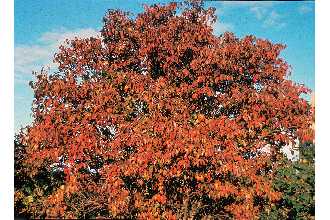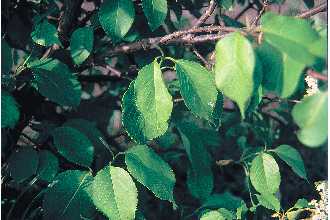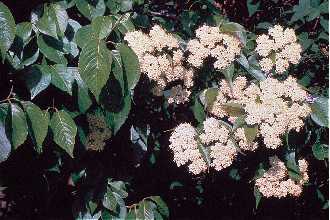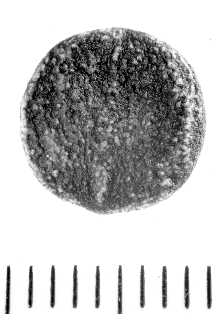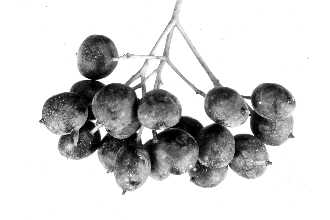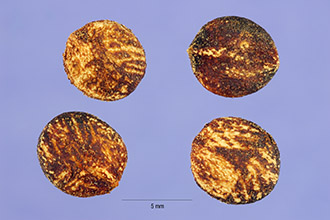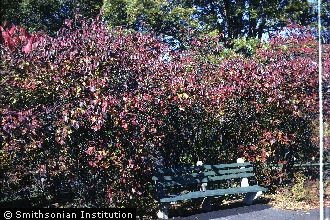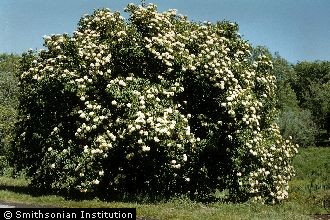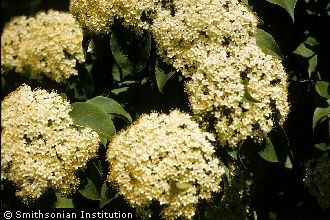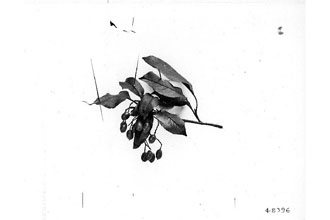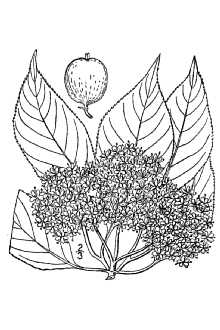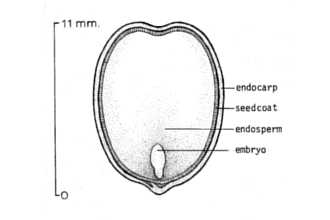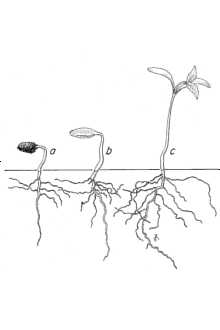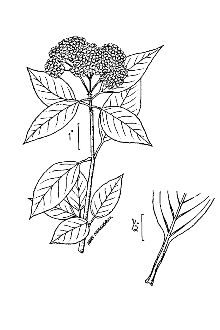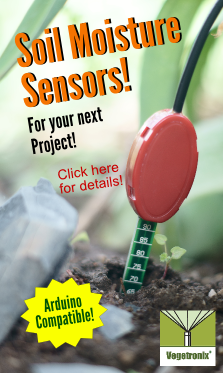Viburnum ×vetteri Zabel
Scientific Name: Viburnum ×vetteri Zabel
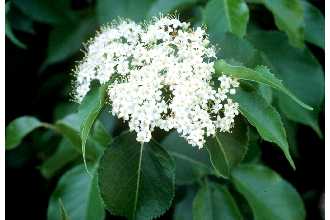
| General Information | |
|---|---|
| Usda Symbol | VIVE4 |
| Group | Dicot |
| Life Cycle | Perennial |
| Growth Habits | ShrubTree, |
| Native Locations | VIVE4 |
Plant Guide
Alternate Names
Sheepberry, wild raisin, sweet viburnum, nanny-berry
Uses
Nannyberry is shade-tolerant species useful in landscape plantings as shrub borders, taller barriers, hedges, and windbreaks. It produces good seasonal displays of flowers, fruits, and fall leaf color and the fruit are eaten by many species of birds and wildlife. Cultivars are not commonly available.
Status
Please consult the PLANTS Web site and your State Department of Natural Resources for this plant’s current status, such as, state noxious status and wetland indicator values.
Description
General: Honeysuckle family (Caprifoliaceae). Native, multi-stemmed shrubs or small trees growing to 9 m high, somewhat open at maturity and leggy at the base, the crown irregular to rounded, often suckering at the base; bark dark gray to black, forming a pattern of small blocks. Leaves are deciduous, simple, opposite, elliptic-obovate to ovate, 5-10 cm long, long-pointed, glabrous or nearly so on both sides, the petiole with a wavy-winged margin, margins finely toothed; mature foliage dark glossy, green, becoming deep maroon to red in the fall. Flowers are small, all bisexual, creamy white, in flat-topped clusters 5-12 cm wide. Fruit in hanging clusters, berry-like (a drupe), oval to nearly round, 10-15 mm long, changing from green to yellow, pink, rose and finally to blue-black, sweet and edible, with an odor of wet sheep wool when ripe and rotting, with a single, smooth, nearly flat stone. © R.A. Seelig Botany Dept., NMNH, Smithsonian Institution @ PLANTS
Distribution
Across northeastern North America, from New Brunswick and Quebec to Saskatchewan, south to Colorado and Nebraska (rare), Missouri (extinct), West Virginia, and Pennsylvania, rare in the Appalachians in Maryland and Virginia and apparently disjunct in Georgia, For current distribution, please consult the Plant Profile page for this species on the PLANTS Web site, A detailed distribution map is also provided by Northern Prairie Wildlife Research Center (2000), , Use soil moisture sensors to measure the soil moisture of Viburnum ×vetteri Zabel.
Adaptation
Common habitats for nannyberry are low woods, swamp borders, and rich valleys at or near streambanks, usually in rich loam to clay-loam soil. It also occurs in moist soil of wooded slopes and other upland sites, sometimes even in sandy or rocky soil. It is a shade-tolerant understory shrub, but reaches relatively larger size in partial openings or along edges. Flowering occurs in May-June and fruits in July–September.
Establishment
Reproduction is primarily by seed. Suckering from the base can replace and add to main stems. The “leggy” habit sometimes allows lower branches to fall over – they root where touching the ground.
Management
Nannyberry is one of the more shade-tolerant woody plants, but it also grows well in open sites. It is tolerant of both moist and dry soils. It is easily transplanted and established and can be propagated by cuttings. Although the growth habit is primarily a multi-stemmed shrub, it can be maintained as a small tree by pruning stems and removing basal suckers. Pests & Potential Problems Nannyberry is susceptible to powdery mildew where air circulation is not good. Infected plants are not killed but the leaves can be discolored and disfigured in late summer and fall. Viburnum leaf beetle. The viburnum leaf beetle (Pyrrhalta viburni), native to Europe and Asia, was first encountered in North America in 1947, perhaps arriving earlier from Europe on nursery plants. It received little notice until 1978, when it caused severe defoliation of ornamental viburnums in Ontario and Quebec. It has now reached western New York and Maine and become a concern in urban landscapes and nurseries. The adult and the larva “skeletonize” leaves by feeding on the leaves between the midrib and larger veins. Plants, which have been defoliated for 2-3 consecutive years, may be killed. The preferred host is Viburnum opulus and its selections; lesser damage is caused to V. lantana and V. acerifolium, V. dentatum, V. lentago, and V. rafinesquianum. Other species, particularly V. rhytidophyllum and V. carlesii, are relatively unaffected. The entire life cycle of the viburnum leaf beetle takes about 8-10 weeks. Larvae hatch in early May and feed on the viburnum leaves throughout the larval period, which lasts 4-5 weeks. The larvae pupate in the soil. The adults (4.5-6.5 mm long, brown) appear by mid-July and continue eating the leaves, then mate and lay over-wintering eggs on the twigs. Egg-laying holes are in a straight line on the underside of the current season's growth. Chemical control of the viburnum leaf beetle is best applied to young larvae, because adults will fly away or drop to the ground if disturbed. If over-wintering egg sites are found, affected wood should be pruned and destroyed before the eggs hatch. Examine upper and lower leaf surfaces for feeding larvae. Potential biological control mechanisms are being studied. Cultivars, Improved and Selected Materials (and area of origin) These plant materials are readily available from commercial sources. Contact your local Natural Resources Conservation Service (formerly Soil Conservation Service) office for more information. Look in the phone book under ”United States Government.” The Natural Resources
Conservation
Service will be listed under the subheading “Department of Agriculture.”
References
Brumbaugh, J.H. & A.T. Guard 1957. A study of evidences of introgression among Viburnum lentago, V. prunifolium and V. rufidulum based on leaf characteristics (Abstr.). Proc. Indiana Acad. Sci. 66:300. Donoghue, M. 1980. Flowering times in Viburnum. Arnoldia 40:2-22. Donoghue, M. 1983. A preliminary analysis of phylogenetic relationships in Viburnum (Caprifoliaceae s.l.). Syst. Bot. 8:45-58. Egolf, D.R. 1962. A cytological study of the genus Viburnum. J. Arnold Arb. 43:132-172. Friedlander, Jr, B.P. 1999. Voracious viburnum leaf beetle munches into Ithaca area. Cornell Chronicle. <http://www.news.cornell.edu/Chronicles/6.17.99/leaf_beetle.html> Hauser, E.J.P. 1965. Characteristics and distribution of Viburnum (Caprifoliaceae) in Georgia. Bull. Ga. Acad. Sci. 23:(11 pages). Jones, T.H. 1983. A revision of the genus Viburnum sect. Lentago (Caprifoliaceae). Ph.D. diss., North Carolina State Univ., Raleigh, North Carolina. Kessel, C. 2000. Viburnum leaf beetle, Pyrrhalta viburni (Paykull), in the nursery and landscape. Ontario Ministry of Agriculture, Food and Rural Affairs, Ontario, Canada. Web site. <http://www.gov.on.ca/OMAFRA/english/crops/facts/vlb.htm> McAtee, W.L. 1956. A review of the Nearctic Viburnum. Published by the author, Chapel Hill, North Carolina. Niering W.A., G.D. Dreyer, F.E. Egler, & J.P.J. Anderson 1986. Stability of a Viburnum lentago shrub community after 30 years. Bull. Torrey Bot. Club 113:23-27. Northern Prairie Wildlife Research Center 2000. Viburnum lentago. NPWRC, Biological Resources Division, U.S. Geological Survey, Jamestown, North Dakota. Web site. <http://www.npwrc.usgs.gov/resource/othrdata/plntguid/species/vibulent.htm>
Fact Sheet
Alternate Names
Sheepberry, wild raisin, sweet viburnum, nanny-berry
Uses
Nannyberry is a shade-tolerant, understory species useful in landscape plantings as shrub borders, taller barriers, hedges, and windbreaks. It produces good seasonal displays of flowers, fruits, and fall leaf color. The fruits are sweet and edible and are eaten by many species of birds and wildlife.
Status
Please consult the PLANTS Web site and your State Department of Natural Resources for this plant’s current status (e.g. threatened or endangered species, state noxious status, and wetland indicator values).
Description
General: Nannyberry is a native, deciduous, multi-stemmed shrub or small tree that may reach 36 ft. in height. The plant is also known as “sheepberry” because its fruit smells like wet sheep wool when over ripe. Nannyberry is leggy and somewhat open at maturity with an irregular to rounded crown. Suckers often form at the base. The bark is dark gray to black in a pattern of small blocks. Leaves are simple, opposite, and ellipse to egg-shaped with finely toothed margins. They are 2-4” long and hairless, or nearly so, on both sides. The ½-1” petiole has a wavy, mostly winged margin. Mature foliage is dark glossy green, becoming deep maroon to red in the fall. Small, creamy-white, bisexual flowers in flat-topped clusters appear May-June. The ½” berry-like fruits (drupes) are blue-black and form hanging clusters from July - September.
Adaptation and Distribution
Distribution
Distribution
© R,A, Seelig Botany Dept,, NMNH, Smithsonian Institution @ PLANTS Nannyberry is adaptable to a wide range of sites, but is commonly found natively in moist areas with rich loam to clay-loam soil, such as low woods, swamp borders, or near stream banks, It also occurs on moist, wooded slopes, but tolerates drier sites, Although quite shade-tolerant, it achieves relatively larger size in more open areas, Nannyberry is distributed throughout the north and northeastern United States, For a current distribution map, please consult the Plant Profile page for this species on the PLANTS Website, Use soil moisture sensors to measure the soil moisture of Viburnum ×vetteri Zabel.,
Establishment
Nannyberry seed requires alternating temperatures and a cool moist period to germinate (Dirr, 1990). The plant can be readily propagated by softwood cuttings. Hanging branches may also root, or layer, where they touch the ground. Nannyberry has fibrous roots and is easily transplanted and established.
Management
Although nannyberry grows naturally as a multi-stemmed shrub, it can be maintained as a small tree by pruning stems and removing suckers at the base.
Plant Traits
Growth Requirements
| Temperature, Minimum (°F) | -33 |
|---|---|
| Adapted to Coarse Textured Soils | No |
| Adapted to Fine Textured Soils | Yes |
| Adapted to Medium Textured Soils | Yes |
| Anaerobic Tolerance | Medium |
| CaCO3 Tolerance | Low |
| Cold Stratification Required | Yes |
| Drought Tolerance | Low |
| Fertility Requirement | Medium |
| Fire Tolerance | Low |
| Frost Free Days, Minimum | 128 |
| Hedge Tolerance | None |
| Moisture Use | Medium |
| pH, Maximum | 7.0 |
| pH, Minimum | 5.0 |
| Planting Density per Acre, Maxim | 1200 |
| Planting Density per Acre, Minim | 300 |
| Precipitation, Maximum | 60 |
| Precipitation, Minimum | 38 |
| Root Depth, Minimum (inches) | 14 |
| Salinity Tolerance | None |
| Shade Tolerance | Tolerant |
Morphology/Physiology
| Bloat | None |
|---|---|
| Toxicity | None |
| Resprout Ability | No |
| Shape and Orientation | Erect |
| Active Growth Period | Spring and Summer |
| Coppice Potential | No |
| Fall Conspicuous | Yes |
| Fire Resistant | No |
| Flower Color | White |
| Flower Conspicuous | Yes |
| Foliage Color | Green |
| Foliage Porosity Summer | Dense |
| Foliage Porosity Winter | Porous |
| Foliage Texture | Coarse |
| Fruit/Seed Conspicuous | Yes |
| Nitrogen Fixation | None |
| Low Growing Grass | No |
| Lifespan | Long |
| Leaf Retention | No |
| Known Allelopath | No |
| Height, Mature (feet) | 28.0 |
| Height at 20 Years, Maximum (fee | 28 |
| Growth Rate | Slow |
| Growth Form | Multiple Stem |
| Fruit/Seed Color | Red |
Reproduction
| Vegetative Spread Rate | None |
|---|---|
| Small Grain | No |
| Seedling Vigor | Low |
| Seed Spread Rate | Slow |
| Seed per Pound | 7843 |
| Fruit/Seed Persistence | No |
| Propagated by Tubers | No |
| Propagated by Sprigs | No |
| Propagated by Sod | No |
| Propagated by Seed | Yes |
| Propagated by Corm | No |
| Propagated by Container | Yes |
| Propagated by Bulb | No |
| Propagated by Bare Root | Yes |
| Fruit/Seed Period End | Fall |
| Fruit/Seed Period Begin | Summer |
| Fruit/Seed Abundance | Low |
| Commercial Availability | Routinely Available |
| Bloom Period | Late Spring |
| Propagated by Cuttings | Yes |
Suitability/Use
| Veneer Product | No |
|---|---|
| Pulpwood Product | No |
| Protein Potential | Low |
| Post Product | No |
| Palatable Human | No |
| Palatable Graze Animal | Low |
| Palatable Browse Animal | Low |
| Nursery Stock Product | Yes |
| Naval Store Product | No |
| Lumber Product | No |
| Fodder Product | No |
| Christmas Tree Product | No |
| Berry/Nut/Seed Product | No |

